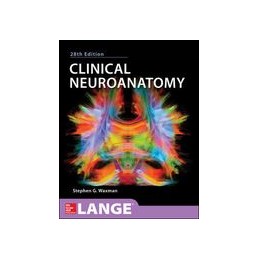- Obniżka


 Dostawa
Dostawa
Wybierz Paczkomat Inpost, Orlen Paczkę, DHL, DPD, Pocztę, email (dla ebooków). Kliknij po więcej
 Płatność
Płatność
Zapłać szybkim przelewem, kartą płatniczą lub za pobraniem. Kliknij po więcej szczegółów
 Zwroty
Zwroty
Jeżeli jesteś konsumentem możesz zwrócić towar w ciągu 14 dni*. Kliknij po więcej szczegółów
A concise, highly visual overview of neuroanatomy and its functional underpinnings
Clinical Neuroanatomy, Twenty-Eighth Edition offers an accessible, easy-to-remember synopsis of neuroanatomy and its functional and clinical implications. Since many of us learn and remember better when material is presented visually, this acclaimed resource includes not only clinical material such as brain scans and pathological specimens, but also hundreds of diagrams and tables that are designed to be clear and memorable.
Heres why Clinical Neuroanatomy is essential for board review or as a clinical refresher::
• NEW SECTION summarizes the most important take-away lessons from each chapter
• More than 300 full-color illustrations
• A unique chapter on Introduction to Clinical Thinking puts neuroanatomy in clear clinical perspective
• Numerous CT and MRI scans
• Block diagrams illustrate actions of each muscle (essential for the clinical motor examination)
• Hundreds of diagrams and tables encapsulate important information
• Essentials for the Clinical Neuroanatomist list appears in each chapter
• Clear and memorable root-by-root and nerve-by-nerve illustrations of sensory areas and muscle intervention
• Coverage of the basic structure and function of the brain, spinal cord, and peripheral nerves as well as clinical presentations of disease processes involving specific structures
• Emphasizes must-know concepts, facts, and structures
• Appendices include The Neurologic Examination, Testing Muscle Function, Spinal Nerves and Plexuses, and Questions and Answers
• Case studies demonstrate how concepts apply to real-world situations
If your practice or education would benefit from an engagingly written, well-illustrated overview of neuroanatomy and its functional underpinnings, this trusted resource belongs on your desk.
Opis
Indeks: 77982
Autor: Cairo Mitchell S
